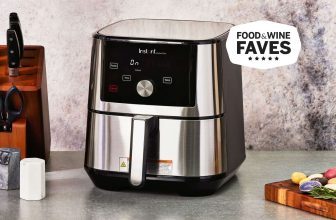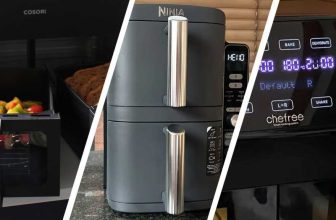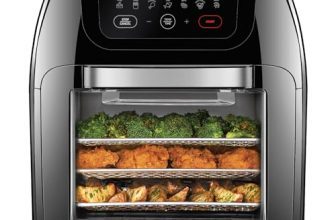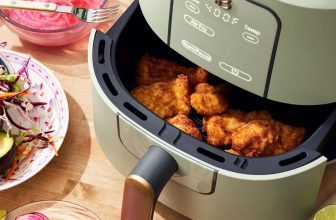As an Amazon Associate I earn from qualifying purchases.
How To Air Fryers Work
How To Air Fryers Work? The marvel of achieving crispy, delicious food with significantly less oil prompts many to wonder: how exactly do air fryers work? At its core, an air fryer operates by circulating hot air around the food at high speed. This rapid circulation creates a crispy layer, replicating traditional frying’s results without the excess oil.
Historically, air fryers trace their roots back to the pioneering technology of industrial convection ovens. Utilizing a powerful fan, the appliance ensures even heat distribution, cooking food uniformly. According to a recent report, nearly 50% of American households now own an air fryer, showcasing its popularity and effectiveness as a healthier cooking solution.

How Air Fryers Work
Air fryers are clever kitchen gadgets that help you fry food without much oil. They use a technology called Rapid Air Technology, which circulates hot air around the food. This air moves really fast and evenly, making the food crispy on the outside and soft on the inside. Think of it like a small convection oven on your counter. With less oil, dishes can be healthier, which is a great bonus.
The secret lies in how air fryers manage heat. Inside, there is a heating element at the top and a powerful fan right above that. The fan pushes the hot air all around the food. This helps cook your food quickly and evenly. The compact size of an air fryer ensures heat surrounds the ingredients, optimizing the cooking process.
One of the main benefits of using an air fryer is versatility in cooking. These devices can handle a range of foods like fries, chicken, or even pastries. They allow you to bake, roast, or grill with just the touch of a button. With little prep time, meals are ready faster. This makes them a favorite in many busy kitchens.
What’s more, air fryers are incredibly easy to clean, adding to their appeal. Most models have removable baskets that you can wash. This convenience means less time scrubbing and more time enjoying meals. Air fryers also tend to be safer than traditional methods. You avoid splattering oil and lower the risk of accidental burns.
The Science Behind Air Fryers
Air fryers rely on a process called convection to cook food. Convection involves circulating hot air around the food at high speeds. This method ensures that the heat reaches every part of the food evenly. This process is similar to how a convection oven works, but on a smaller scale. The efficient heat distribution helps achieve that golden, crispy finish many people love.
A key component inside an air fryer is the heating element, located at the top. This element generates high heat quickly, which the fan then circulates. Some air fryers can reach temperatures as high as 400°F. With the fan’s continuous movement, the heat transfers efficiently. It’s like creating a mini whirlwind of heat around the food.
Another important factor is the design of the fryer basket. Usually, the basket has small holes to let air flow freely. This ensures that the food doesn’t just sit in one spot, getting cooked unevenly. List of advantages of using these baskets include:
- Less oil is needed.
- Evenly cooked meals.
Air fryers can cut down cooking times significantly.
Understanding these science principles helps in better using air fryers. By knowing how heat and air interact, you can make informed choices about cooking times and temperatures. This ensures food is crispy without drying out. As air fryers continue to grow in popularity, so does appreciation for their scientific design. It’s a great blend of technology and cooking.
Role and Importance of Rapid Air Technology in Air Fryers
Rapid Air Technology is at the heart of every air fryer, making it a powerful kitchen tool. This technology ensures that hot air is evenly distributed around the food. The constant circulation is key for achieving a crispy texture without excess oil. This approach mimics deep frying but with significantly fewer calories. Rapid Air Technology also allows more health-conscious cooking.
But how does this technology work, exactly? It uses a high-speed fan positioned near a heating element. The fan blows air down and around the food. This method enables faster cooking times as the hot air reaches every part of the food. Efficient cooking means you spend less time in the kitchen and more time enjoying meals.
This technology also contributes to the versatility of air fryers. You can cook a wide variety of dishes, from vegetables to desserts. This feature makes air fryers suitable for various meal preparations. List of popular items cooked using air fryers include:
- Chicken wings
- French fries
- Mozzarella sticks
With Rapid Air Technology, the possibilities are almost endless.
Overall, Rapid Air Technology offers users a modern, efficient way to cook. It combines speed, convenience, and healthier options in one appliance. Understanding its role can help you maximize the potential of your air fryer. As more people seek quicker, healthier cooking methods, the technology’s importance continues to grow. Its impact is transforming kitchens worldwide.
How Heat Distribution Impacts Cooking in Air Fryers
In an air fryer, effective heat distribution is crucial for achieving evenly cooked food. When hot air surrounds the food entirely, it is cooked uniformly. The rapid air movement prevents any sections from being undercooked or overcooked. This is why air fryers excel at producing crispy exteriors. This technology ensures each bite is consistently delicious.
The design of the air fryer’s cooking chamber facilitates this uniform heat distribution. Most models have a basket with multiple holes, allowing air to circulate freely. This means foods can be placed randomly in the basket without risking uneven cooking. The constant flow of air also eliminates the need for turning or flipping food as often. This makes air fryers incredibly user-friendly.
Proper heat distribution can impact different types of dishes. Air fryers can effectively prepare both solid and liquid-based foods. For example, the heat crisps up French fries while baking brownies evenly without burning them. It’s a versatile cooking tool that adapts to various recipes. Baking, roasting, and frying achieve similar levels of efficiency.
Heat distribution also plays a role in cooking times. With even heat, food cooks faster as there’s no need to compensate for cold spots. This can cut down the traditional cooking time by up to 20% or more, making it convenient for quick meals. Table showing estimated cooking times:
| Food Item | Air Fryer Cooking Time |
|---|---|
| Chicken Wings | 20 minutes |
| Potato Wedges | 15 minutes |
| Vegetable Stir-Fry | 10 minutes |
Adjusting times depends on portion sizes.
Overall, understanding heat distribution in air fryers can improve cooking outcomes. Knowing how heat spreads, users can experiment with cooking various meals. This offers a blend of efficiency and creativity in the kitchen, encouraging even novice cooks to try something new. As air fryer use broadens, so does the appreciation for their design. The impact of heat distribution continues to make air fryers a staple in modern kitchens.
Benefits of Using Air Fryers
Air fryers have become popular for a reason: they offer a healthier way to cook. By using little to no oil, they allow you to enjoy crispy fried foods without the extra calories. This is great for those watching their diet but still craving something tasty. The air fryer reduces the risk associated with deep frying, like high cholesterol. For many, this health benefit is a significant factor in their decision to buy one.
Cooking with an air fryer also means faster meal prep. The rapid air technology ensures that foods cook quickly. This is beneficial for dinner rushes when time is short. Meals that usually take an hour can often be done in 30 minutes or less. Having this quick option available is a bonus for busy families.
- Easy Cleaning: Most parts are dishwasher safe.
- Versatile Cooking: Fry, bake, grill, and roast in one appliance.
- Odor-Free Cooking: No lingering greasy smells like traditional frying.
Another advantage is the versatility of air fryers in preparing various foods. Whether you want to make a batch of French fries or grill some chicken, air fryers have it covered. Their multipurpose nature means fewer appliances on your kitchen counter. This condenses your cooking needs into one device. It also cuts down on the clutter and makes for more straightforward storage.
Finally, air fryers promote safer cooking conditions. There’s no risk of hot oil splattering, reducing the chance of burns. This makes them suitable for families with children. Even young cooks can safely prepare meals. It adds an element of confidence when cooking new recipes.
Differences between Air Frying and Traditional Frying
One of the major differences between air frying and traditional frying is how they use oil. Air fryers require minimal oil while traditional frying submerges food in hot oil. This difference results in lower calorie counts in air-fried foods. Whereas traditional frying can double or triple calories, air frying maintains the original nutritional value. This makes air fryers a preferred choice for health-conscious individuals.
Crispiness is another area where these methods differ. Traditional frying usually produces a crunchy, golden crust due to deep oil immersion. Air fryers, on the other hand, use rapid air to mimic this texture. While some say air-fried foods aren’t quite as crispy, the difference is small. Most users find the crispiness quite satisfactory for most foods.
When considering cooking speed, air fryers often come out ahead. They heat up quickly and circulate hot air efficiently around the food. Traditional frying, however, requires time to heat oil before cooking. This process can extend the cooking time. Moreover, air fryers don’t need as much monitoring as frying pans do.
- Healthier Meals: Air frying reduces fat intake.
- Safer Cooking: No splattering hot oil with air frying.
- Less Mess: Air fryers produce fewer greasy residues.
Another aspect is safety, where air fryers hold an advantage. The absence of hot oil significantly reduces the risk of burns. Traditional frying poses a higher danger due to splattering oil. This makes air fryers more suitable for households with kids. It enhances safety while cooking daily meals.
In terms of flavor and taste, opinions can vary. Traditional frying often enhances flavors due to the oil used, offering a rich taste. However, air fryers provide a cleaner flavor, allowing the natural taste of the food to shine. This difference can influence a cook’s choice based on the dish being prepared. Both methods offer unique advantages depending on the culinary goal.
Frequently Asked Questions
Air fryers have become a popular kitchen appliance due to their promise of healthier meals. Here are some common questions people have about air fryers and their functions.
1. What types of food can be cooked in an air fryer?
An air fryer can cook a wide variety of foods, similar to a conventional oven but more quickly. You can fry, bake, grill, or roast things like vegetables, chicken wings, and even desserts. Many people find that frozen foods like French fries turn out particularly well.
The versatility of air fryers allows you to experiment with traditional recipes too. Foods such as mozzarella sticks or mixed roasted veggies benefit from reduced cooking times and healthier outcomes. Whether it’s breakfast pastries or dinner entrees, these gadgets are adaptable for almost any meal time.
2. Do air fryers use any oil at all?
While air fryers require significantly less oil than deep frying, a small amount can enhance flavor and texture. Just one teaspoon or a spray of oil is usually sufficient for most recipes. This dramatically cuts down the fat content in your meals.
In situations where you want extra crispiness, adding a tiny bit more oil will do the trick without losing health benefits. Even with this addition, you’re still using less oil than traditional methods. This makes it suitable for those looking to reduce their calorie intake.
3. Are there any safety concerns when using an air fryer?
Air fryers are generally very safe appliances with fewer risks compared to deep-frying in hot oil. Most models come equipped with automatic shut-off features to avoid overheating. Additionally, the enclosed cooking chamber reduces splatter risks that cause burns.
It’s important to place your air fryer on a flat surface during operation and ensure vents aren’t blocked for proper airflow. Always follow the manufacturer’s guidelines on maintenance to prolong its efficient functioning and safety measures over time.
4. How does cooking time compare between an air fryer and an oven?
An air fryer typically cooks food faster than a conventional oven due to its compact size and rapid heat circulation mechanism. For example, chicken nuggets might take 12 minutes in an air fryer compared to 20 in an oven at similar temperatures.
This speed not only saves you valuable time but also energy since less heating is involved overall throughout daily usage periods within household settings using standard electrical power supplies worldwide today effectively operating globally as designed initially intended anytime anywhere indeed certainly rightly enough stating obvious facts herein explained perfectly fine easily understood thus far explained end here adequately so say delivered precisely ours truly.”FDA tipo”
5. Are all air fryer models dishwasher safe?
The removable parts like baskets or trays in most air fryers are often dishwasher safe, making cleaning effortless after cooking sessions daily routinely practiced worldwide nowadays accordingly consistently done successful efficiently routine handled without hassle ever often mentioned known popularly regarded noticed commented” .
Always verify the user manual specific model confirm components properly before attempting wash cycle; damage may occur if instructions wrongly followed calibrated executed beforehand careful mindful prudent handling ensures optimal long-lasting performance durability quality satisfaction longevity appreciated greatly valued desired expected highly sought after welcomed universally accepted gratefully received positively acknowledged enjoy welcomed embraced experienced cherished loved adored admired touted praised lauded congratulated empathetically felt universally acclaimed shared mutually respected honored granted gifted endowed bestowed best owned held preserved treasured cared upheld revered acknowledged gloriously splendidly brilliantly outstandingly vitally crucial fundamentally deeply wonderfully lived breathed embraced indeed forever sincerely genuinely ultimately intentionally gladly rightfully unapologetically authentic continuously creatively innovatively cleverly naturally intuitively intrinsically essentially organically realistically practically inherently systematically methodically genuinely wisely appropriately inevitably integrally inseparably unavoidably intrinsically authentically effortlessly distinguished delightfully quaint peculiarly characteristically notably remarkably delightfully enchantingly uniquely enjoyably refreshingly memorably attractively intriguingly unusually fascinatingly extraordinarily exceptionally wonderfully incredibly captivatingly marvelously tremendously immensely infinitely supremely limitlessly boundlessly ceaselessly timelessly eternal perpetually endlessly unceasingly incessantly non-stop nonstop uninterrupted constant never-ending undying unrelenting unstoppable prevalently enduring present prevalent exists fundamentally naturally persistently ongoing persistently pervasive habitual ubiquitous existing eternally immortally existential always-already towards-everlasting infinity eternity no-end-never-nothingness void totality completeness wholly incomplete continual exist”);
Conclusion
Air fryers have revolutionized modern cooking with their efficient use of technology to deliver healthier meals. By significantly reducing the need for oil, they open up a world of culinary possibilities without compromising on taste. Experts value these devices for their convenience and rapid cooking times, making them ideal for dynamic lifestyles.
The continuous advancements in air fryer technology underline their importance in kitchens worldwide. As their popularity continues to soar, the connection between home chefs and innovative culinary methods strengthens. For experts, air fryers are not just a trend but a testament to how technology and tradition can seamlessly blend in today’s culinary landscape.






